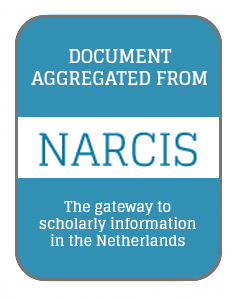Focal point
Location
National Academic Research and Collaborations Information System (NARCIS) is the main Dutch national portal for those looking for information about researchers and their work. NARCIS aggregates data from around 30 institutional repositories. Besides researchers, NARCIS is also used by students, journalists and people working in educational and government institutions as well as the business sector.
NARCIS provides access to scientific information, including (open access) publications from the repositories of all the Dutch universities, KNAW, NWO and a number of research institutes, datasets from some data archives as well as descriptions of research projects, researchers and research institutes.
This means that NARCIS cannot be used as an entry point to access complete overviews of publications of researchers (yet). However, there are more institutions that make all their scientific publications accessible via NARCIS. By doing so, it will become possible to create much more complete publication lists of researchers.
In 2004, the development of NARCIS started as a cooperation project of KNAW Research Information, NWO, VSNU and METIS, as part of the development of services within the DARE programme of SURFfoundation. This project resulted in the NARCIS portal, in which the DAREnet service was incorporated in January 2007. NARCIS has been part of DANS since 2011.
DANS - Data Archiving and Networked Services - is the Netherlands Institute for permanent access to digital research resources. DANS encourages researchers to make their digital research data and related outputs Findable, Accessible, Interoperable and Reusable.
Members:
Resources
Displaying 161 - 165 of 1863Environmental justice as a (potentially) hegemonic concept: A historical look at competing interests between the MST and indigenous people in Brazil
This article explores the need to recognise and compensate the plurality of
environmental justice claims, while paying close attention to the outcomes
of the most marginalised groups – cultural
Direct and indirect loss of natural habitat due to built-up area expansion: A model-based analysis for the city of Wuhan, China
Urbanization has been responsible for the loss of cropland worldwide, especially in China. To guarantee national food security, China has implemented a series of policies to protect cropland. One of these policies requires that one-hectare cropland should be reclaimed when urban expansion occupies one-hectare cropland. Since most cropland reclamation leads to a conversion of natural habitat, such as wetland and grassland, urban expansion may lead to (indirect) natural habitat loss in addition to direct loss from conversion of into urban area.
Fire-induced deforestation in drought-prone Mediterranean forests : drivers and unknowns from leaves to communities
Over the past 15 years, 3 million hectares of forests have been converted into shrublands or grasslands in the Mediterranean countries of the European Union. Fire and drought are the main drivers underlying this deforestation. Here we present a conceptual framework for the process of fire-induced deforestation based on the interactive effects of fire and drought across three hierarchical scales: resistance in individuals, resilience in populations, and transitions to a new state.
Improved drought detection to support crop insurance models: powerpoint
Anomaly assessment for drought monitoring, as required for index insurance applications, is commonly done by comparing actual NDVI measurements against their historical records on a pixel-by-pixel basis. Limited years of satellite records with operational real-time availability result in time-series with a relative low count in annual repeats, e.g., the VEGETATION sensor onboard SPOT and Proba-V has completed at present only 19 full annual repeats. This number is too low for agricultural index insurance models that require accurate assessments of impacts of perils (e.g.
Models meet data: Challenges and opportunities in implementing land management in Earth system models
As the applications of Earth system models (ESMs) move from general climate projections toward questions of mitigation and adaptation, the inclusion of land management practices in these models becomes crucial. We carried out a survey among modeling groups to show an evolution from models able only to deal with land-cover change to more sophisticated approaches that allow also for the partial integration of land management changes. For the longer term a comprehensive land management representation can be anticipated for all major models.



